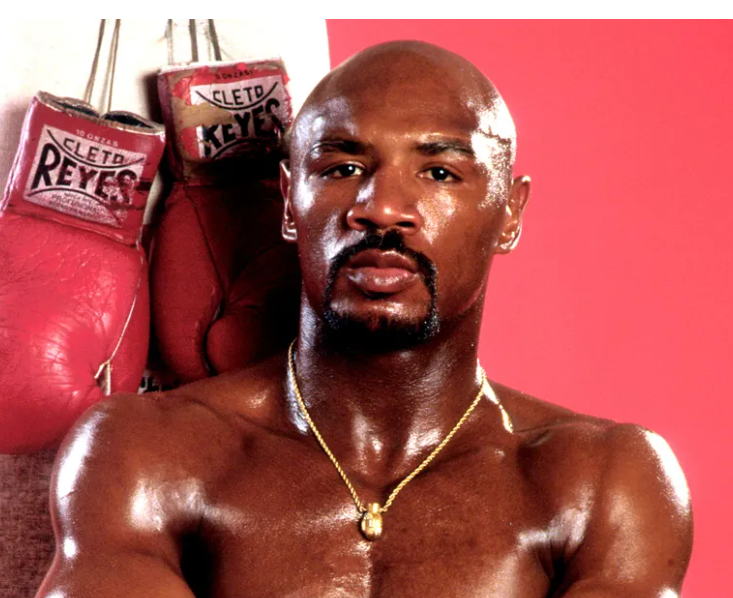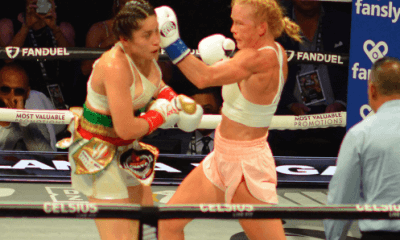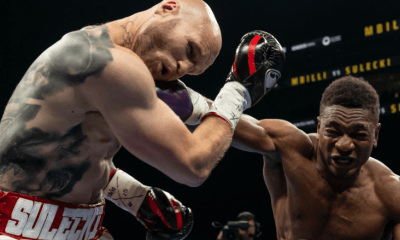Featured Articles
A Talk With Rick Telander Who Ruminates on the Marvin Hagler That He Knew

Sunday, March 13, marked the first anniversary of the death of Marvelous Marvin Hagler who was 66 when he passed away at his home in Bartlett, New Hampshire. During a 14-year career as a pro that began in 1973, Hagler had 67 professional fights, winning 62 with three defeats and two draws with 52 wins coming via knockout or stoppage.
Hagler experienced many highs and a few lows, one of which truly stood out. The date was April 6, 1987 and the site was Caesars Palace in Las Vegas when he took on Sugar Ray Leonard, who over the course of 12 rounds, edged Hagler on a split decision.
As it turned out, this would be the last time Hagler, the undisputed middleweight champion from 1980 through 1987, would step into a ring, and it surprised many.
Three years later, Rick Telander, then with Sports Illustrated, paid Hagler a visit in Milan, Italy, where he was living and working.
Telander’s story appeared in the July 2, 1990, issue with Hagler smiling on the cover and the headline blaring “It’s A Marvelous Life” and the subhead reading “Pugilist-Turned-Actor Marvin Hagler At Home In Milan – Far Away From Sugar Ray.”
On the surface, and according to Telander, Hagler seemed at peace with his life. “He was making the best of that necessary transition, that little death we all athletes must experience – the end of a career or dream that is based on and dependent on one’s youth,” he said.
That middleweight clash with two belts on the line was razor close and had some ringside observers siding with Hagler and others favoring Leonard.
Judge Lou Filippo had Hagler winning 115-113 while Dave Moretti scored it 115-113 in favor of Leonard. The most lopsided score came from JoJo Guerra, who had Leonard claiming a 118-110 victory.
Ron Borges of the Boston Globe, ESPN’s Al Bernstein, Jerry Izenberg of the Newark Star-Ledger, and Pat Putnam of Sports Illustrated were among those sitting close to the action who scored the fight for Hagler. They all had it 115-113.
Those who felt Leonard won included ABC’s Howard Cosell and Michael Katz of the New York Daily News. Both had it 117-112.
Others who gave Leonard the decision were Sports Illustrated’s William Nack (116-114) and Gil Clancy of CBS (115-113).
Some saw it deadlocked including HBO’s Larry Merchant and Dave Anderson of the New York Times. Each had it 114-114. Because so many at ringside had differing views, it’s clear the fight could have gone to either man.
In all likelihood, Hagler, born in Newark, New Jersey, and raised in Brockton, Massachusetts, had enough talent, skill and determination that he could have continued to box and perhaps avenge that setback to Leonard. In fact, Top Rank CEO Bob Arum offered Hagler a minimum of $15 million for a rematch, but Hagler declined.
What is Rick Telander’s sense of why there wasn’t a second fight?
“That remains a mystery. It is possible he actually was content with quitting boxing, with moving on to a new life, a new career, a wholly new chapter in a new land,” he offered. “And money had nothing to do with it. Some people must be like that. It seems improbable. Freddie Roach once told me no boxer he ever trained – including, of course, himself – ever left as champion. Perhaps Hagler truly was at peace with his legacy and ambition. It’s also possible he knew he was done as a fighter, that he could never beat Leonard or these “pretty boy” fighters coming along.”
Telander, the lead sports columnist at the Chicago Sun-Times, continued: “I could never tell,” he said. “And I think those that make a declaration about his intentions and mental state are only speculating, devising judgment from their own states of mind and extrapolations.”
Still, having to live with that loss, a fight Hagler believed he won, had to have played with his ego?
“I know it was a heavy burden on him. It was the end, or the start, or something powerful in his life,” Telander said. “He never went back. Never turned around. Never said he’d kill Leonard in a rematch, never boasted. He just left the fight game. That is some kind of catalyst.”
Telander, who has had eight stories included in the Best American Sports Writing anthologies and was the 2020 recipient of the Dan Jenkins Medal for Excellence in Sportswriting, said Hagler seemed to enjoy interacting with people he would meet in Italy.
Had Hagler in fact gone from fierce warrior to gentle soul practically overnight?
“I don’t think he was a changed man. I think for the most part he was always that way. I think a kind of “split personality’’ in athletes in violent sports is way more common than most fans and observers know,” said Telander, a one-time football standout at Northwestern University who was drafted in 1971 by the Kansas City Chiefs in the eighth round.
“I know lots of football players, linebackers, headhunters and the like, who are vicious, what we might call “killers” on the field but are pussycats off it. The athletes who can’t turn aggression off, or who are only brutal and nasty in life and everywhere, who aren’t able to socialize themselves – those are the ones who get in trouble. Our prisons are filled with them. It’s a very thin line to walk. The best do it naturally. Others must work at it. I think Hagler, like many boxers, realized the ring was his special place to become that other thing, and outside it he could turn the rage off.
I could be wrong. George Foreman had a seeming personality change – from a nasty, nonverbal thug to a smiling sweet guy – near the end of his youthful career. Then he got back in the ring and could be aging George Foreman with an attitude, while selling grills on the side. Hagler, I feel, had that in him too. He just never re-entered the ring.”
Was it better that Hagler left the big stage fully intact and with a brain that still functioned?
“He may have gotten out to keep his wits intact. Leonard shocked him – he says he never was hurt, and he likely was not. But Leonard also may have shown him how close he was to a serious disaster,” Telander said. “He didn’t know about CTE back then, but he certainly knew about pugilistica dementia – ‘punch drunk.’’’ Old, pitiable, punch-drunk boxers were everywhere.”
Telander, the author or co-author of 10 books including the classic “Heaven Is A Playground,” has interviewed some of the biggest names in sports, but said Hagler is one of his favorites.

Telander
“I’d put him right near the very top, maybe at the top. That is because I talked to him when he was in an entirely different country, speaking a different language, in a different craft than the one he’d utilized to become rich and famous,” he said. “He was a different thing. He was reborn.
He was, in certain lights, a loser on the run. In other ways, he was a big winner on a new adventure. He was in control of his new life, and for many ex-athletes, that is rare.”
Like so many, Telander is torn between the violence in boxing and whether it belongs in a civilized society.
“Boxing is a paradox for me. I think it’s terrible and should be banned (like MMA) – attempting to kill another man’s body and/or brain – what can be right about that? But still I like, even at times love, the sport,” he said. “It shouldn’t be that way. It’s embarrassing to feel this way. But it is such a difficult, primitive, beautiful, hideous, fascinating sport – what can I say?”
Regardless of how one feels on this issue, the manly sport, although often cruel and certainly unforgiving, can also save individuals like Hagler and so many others from a life of poverty and ruin.
To comment on this story in the Fight Forum CLICK HERE
-

 Featured Articles3 weeks ago
Featured Articles3 weeks agoAvila Perspective, Chap. 330: Matchroom in New York plus the Latest on Canelo-Crawford
-

 Featured Articles1 week ago
Featured Articles1 week agoVito Mielnicki Jr Whitewashes Kamil Gardzielik Before the Home Folks in Newark
-

 Featured Articles4 weeks ago
Featured Articles4 weeks agoAvila Perspective, Chap 329: Pacquiao is Back, Fabio in England and More
-

 Featured Articles3 weeks ago
Featured Articles3 weeks agoOpetaia and Nakatani Crush Overmatched Foes, Capping Off a Wild Boxing Weekend
-

 Featured Articles2 weeks ago
Featured Articles2 weeks agoCatching Up with Clay Moyle Who Talks About His Massive Collection of Boxing Books
-

 Featured Articles3 weeks ago
Featured Articles3 weeks agoFabio Wardley Comes from Behind to KO Justis Huni
-

 Featured Articles1 week ago
Featured Articles1 week agoMore Medals for Hawaii’s Patricio Family at the USA Boxing Summer Festival
-

 Featured Articles4 weeks ago
Featured Articles4 weeks agoDelving into ‘Hoopla’ with Notes on Books by George Plimpton and Joyce Carol Oates





















